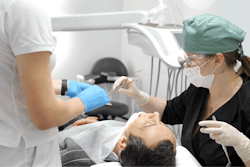“Once perio maintenance, always perio maintenance” is a perpetual coding myth that the CDT Current Dental Terminology Coding Companion (Page 184) dispelled in 2023. Even so, controversy continues to hamper billing systems in dental practices. For many years, dentists and dental hygienists were taught that once a patient was diagnosed with periodontal disease, they had it for life and could never return to a preventive service such as D1110 (prophy).
 Estela Vargas, CRDH.
Estela Vargas, CRDH.
D4910 is the CDT code for periodontal maintenance. The procedure is provided following periodontal therapy and continues at varying intervals, determined by the dentist's evaluation. The code status continues for the life of the dentition or any implant replacements.
According to the ADA, it is appropriately reported as D4910 after periodontal surgery or therapy. Still, if the treating dentist determines the patient's oral health can be augmented or supplemented with routine prophylaxis, D1110 may be indicated.
Depending on the dentist's evaluation of the clinical evidence, it's OK to alternate between prophy and perio maintenance codes. Some dental plans have limitations on the frequency of reimbursement for D4910. In this situation, alternating the D1110 with the D4910 code ensures that the patient receives proper care.
Code D4910 is a challenge for insurance payers to adjudicate. Knowledge of the patients' prior periodontal history is necessary to consider reimbursement for this code. The dental practice may not have this information from the patient when the claim is filed. If the patient has no prior claim history with the payer, or previous periodontal services were not paid for by the current payer, it is difficult to properly assess the benefits, and the insurer will likely request more information from your practice, which leads to delays in paying the claim.
Along with stipulating that you provide a history of periodontal therapy or surgery, many payers require a current examination, targeted periodontal probing, radiographs, and a periodontal diagnosis to reimburse code D4910. The CDT does not dictate the time between therapy and maintenance. Most payers require a waiting period of eight to 12 weeks.
If the dentist determines otherwise, documentation by the treating dentist must demonstrate the clinical rationale. The coding of services is not determined by the benefit package but is supported by individual dental-medical necessities at each encounter.
 Belle DuCharme.
Belle DuCharme.
To build patient trust and treatment acceptance, verifying the individual plan benefits before treatment will best explain that the benefits may only cover some necessary services.
To illustrate a possible coding scenario for a patient with signs of periodontal disease, we offer the following example.
Case history: Jane Doe, a 45-year-old woman, presents for a limited new patient exam. Her chief complaint is, “My teeth feel sore, and my breath always smells bad.”
Visit 1 -- Initial evaluation
During the limited examination, Dr. Smith noted heavy generalized supragingival and subgingival calculus, and spot probing showed pockets ranging from 2 mm to 7 mm. Jane states that she smokes “a pack a day.” D0140 and D0210 are completed.
Dr. Smith prescribes a full-mouth debridement. CDT code D4355. The hygienist completes the debridement with topical anesthetic and localized anesthesia due to Jane's intolerance to the Cavitron/Piezo. D4355 is completed.
The hygienist reviewed beginner oral hygiene instructions with Jane. D1330 is completed.
Visit 2 -- Comprehensive evaluation (two weeks later)
The patient exhibits signs of periodontal disease. A six-point periodontal chart is completed. Gingival inflammation, erythema, and suppuration have decreased since debridement.
The evaluation reveals localized 4-mm to 5-mm pockets on the posterior molars and generalized gingival recession on the lower anterior and upper posterior teeth. The posterior teeth present with 5 mm to 7 mm of clinical attachment level. D0180, comprehensive periodontal evaluation is completed.
Dr. Smith reviews the information and diagnoses Jane with stage III grade C periodontal disease. He prescribes four quadrants of localized scaling and root planing (SRP), D4342.
The hygienist initiates the diagnosed treatment during this visit. She completes all four quadrants, as Jane cannot afford to take additional time off work to split the appointments. D4342 (for all four quadrants) is completed.
At the end of the nonsurgical periodontal therapy (NSPT), the hygienist applied fluoride varnish to all exposed root surfaces, D9910, as Jane complained of root sensitivity after the full-mouth debridement. D9910 is completed.
The hygienist spends an additional 15 minutes with Jane updating the oral hygiene instructions (D1330) and giving her new brushing and flossing techniques. D1330 is completed.
During the NSPT, the hygienist spends considerable time educating Jane about her periodontal disease and the effect that tobacco cessation could have on improving her periodontal health (D1320). D1320 is completed.
Later that evening, the hygienist phoned Jane to hear her post-appointment feedback. Jane describes still being numb in half of her mouth as well as experiencing sore gums and bruising inside her cheek.
After further discussion with Dr. Smith, Dr. Smith determined that Jane is experiencing discomfort from the injection sites of the local anesthetic. The hygienist reassured Jane that the discomfort would subside in three to five days. Dr. Smith recommended that Jane take ibuprofen (after clarifying her health history) as needed for the soreness. Jane is happy with the follow-up and individual attention from her new dentist.
Visit 3 -- Reevaluation (six weeks later)
Jane presents for post-SRP evaluation, D0171. The periodontal chart is updated. Jane’s home care has improved, she reports smoking five cigarettes daily, and most pockets have disappeared. The staff celebrates Jane’s success in reducing the number of cigarettes she smokes daily and encourages her to keep going.
A few stubborn areas are present with 4-mm to 5-mm depths, but there is no bleeding. Dr. Smith prescribes prophylaxis to remove staining and control biofilm. No subgingival scaling was indicated during this visit. D0171 and D1110 are completed.
Dr. Smith diagnoses Jane’s recommended maintenance as follows: Jane is scheduled for four yearly hygiene visits, alternating between D4910 and D1110, as indicated. If Jane has pockets but no bleeding, she will receive prophylaxis, D1110.
If she has bleeding or problem areas, she will receive periodontal maintenance, D4910. The clinical team will update Jane's periodontal charting at each visit to determine the appropriate maintenance regimen.
Two years later
Jane has complied with her maintenance schedule and has stopped smoking! The new periodontal charting shows no pockets and no bleeding. The recession numbers did not change. Vertical bitewings, D0277, show no progression of bone loss.
Dr. Smith has updated Jane’s periodontal classification to stage III, grade B. Her maintenance schedule remains the same, as Jane is at high risk of relapsing due to cigarette cravings and she reported a recent decline in her mental health. At each hygiene visit, the hygienist will spend additional time with Jane for tobacco counseling. Codes D0120, D0277, D1320, and D1110 are completed.
It is important to note that there are varying degrees of success in treating patients with periodontal disease, so the treating dentist and clinical team must view each case individually. It is impossible to make firm recommendations based on a few case studies. Sometimes, a need for antimicrobials at the pocket sites is indicated, while sometimes, testing for a specific pathogen is indicated.
Patients are often motivated by the possibility of returning to "regular cleanings," which is the carrot that was the most successful motivator for my hygiene patients. It motivated them to improve their oral health to qualify for regular cleanings again. A rigid belief such as “once perio, always perio” closes the door to the possibility of improvement in a patient’s health and can be discouraging for many.
Estela Vargas, CRDH, is the founder and CEO of Remote Sourcing, a dental insurance billing and revenue recovery service. She is a graduate of Miami Dade College's dental hygiene program. Vargas' extensive background in the clinical arena of dentistry is coupled with her experience as a practice administrator and business executive.
Belle DuCharme has been a dedicated writer, speaker, and consultant for the dental profession for decades. With a solid foundation in practice management and clinical experience, DuCharme has helped hundreds of dental clients achieve practice growth and stability. Her mission is to help other dental professionals create standards for financial and clinical success. You can reach her at [email protected].
The comments and observations expressed herein do not necessarily reflect the opinions of DrBicuspid.com, nor should they be construed as an endorsement or admonishment of any particular idea, vendor, or organization.



















